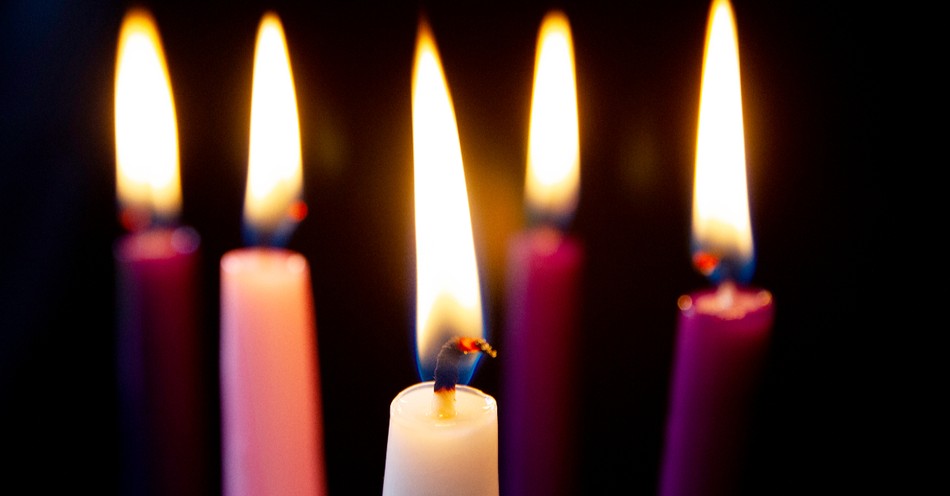Have you ever looked at an Advent wreath and wondered why there are three different candle colors used on it? The three Advent candle colors, purple, pink, and white, have deep spiritual symbolism and are representative of the faithful anticipation that believers partake to ready their hearts and minds for the birth or second coming of Jesus Christ.
The meaning of the season of Advent is to ready one's heart for the arrival of Christ at Christmas. Through the four weeks of Advent, Christians use a wreath, typically consisting of evergreen branches, decorated with five candles to symbolize several sacred phases of preparation. The circular shape of the wreath represents eternity and the unending cycle of God's love. It is usually made of evergreen branches, which symbolize the enduring life and hope brought by Jesus Christ. These candles are traditionally lit on each of the four Sundays of Advent, starting on the fourth Sunday before Christmas.
"But you, O Bethlehem Ephrathah, who are too little to be among the clans of Judah, from you shall come forth for me one who is to be ruler in Israel, whose coming forth is from of old, from ancient days." ~ Micah 5:2
"For to us a child is born, to us a son is given; and the government shall be upon his shoulder, and his name shall be called Wonderful Counselor, Mighty God, Everlasting Father, Prince of Peace." ~ Isaiah 9:6
These three central colors of Advent are endowed with profound themes and meaning. Improve your understanding and gratitude of the Advent season by knowing what each color signifies and why it is used on the Advent wreath.
Table of Contents
Purple Advent Candle Meaning and Symbolism
Purple has traditionally been the central color of Advent. This color signifies repentance and fasting. The Christian custom of withholding oneself food or some other desire is a practice wherein Christians demonstrate their devotion to God and sanctify their heart and body. Purple symbolizes the somber and reflective nature of this period as Christians prepare to commemorate the birth of Jesus.
Purple is also the liturgical color for Lent, which likewise incorporates a time of contemplation, repentance, and spiritual preparation. The use of purple during both Advent and Lent underscores the parallel themes of preparation and spiritual reflection.
Purple has historically been associated with royalty and kingship. The purple advent candle also symbolizes the supremacy and kingship of Christ, who is recognized as the "King of Kings." So, purple in this use illustrates the expectation of and welcoming of our King celebrated during Advent. The following candles of the Advent wreath are traditionally purple:
The first Advent candle, known as the prophecy candle, or candle of hope.
The second Advent candle called the Bethlehem candle or the candle of peace.
The fourth Advent candle called the angel candle or the candle of love.
Get your FREE copy of 25 Days of Advent Devotionals and Readings! Print these and share them with family and friends to keep your mind's attention and heart's affection on Jesus this holiday season.
Pink Advent Candle Color Meaning and Symbolism
The third Advent candle color is pink, called the shepherd candle or candle of joy.
Pink is the color of Advent used during the third Sunday of Advent, known as Gaudete Sunday. The term "Gaudete" comes from the Latin word for "rejoice," and it signifies a sense of joy and anticipation as Christmas approaches. Pink represents joy or triumph and this candle exhibits a transition in the season of Advent away from repentance and to a celebration. On Gaudete Sunday, a pink candle is typically lit in the Advent wreath to represent joy and the nearness of the birth of Jesus Christ.
The scripture readings for the pink candle may include passages that emphasize joy and rejoicing, such as Philippians 4:4-7 - "Rejoice in the Lord always. I will say it again: Rejoice! Let your gentleness be evident to all. The Lord is near. Do not be anxious about anything, but in every situation, by prayer and petition, with thanksgiving, present your requests to God. And the peace of God, which transcends all understanding, will guard your hearts and your minds in Christ Jesus."
White Advent Candle Meaning and Symbolism
The Christ candle is the fifth Advent candle, placed in the center of the wreath as a white candle.
The white Christ candle is lit on the fourth Sunday of Advent, representing the completion and fulfillment of the Advent season as it transitions into the Christmas celebration. It signifies the culmination of the Advent journey and the anticipation of Christ's birth. White is the Advent candle color symbolizing purity, light, restoration, and holiness. White is also a representation of victory.
This white candle at the center of the Advent wreath, which is often called the "Christ candle." This white candle symbolizes the purity and light of Christ. It is typically lit on Christmas Eve or Christmas Day to represent the arrival of Jesus Christ, who is seen as the "Light of the World" and the embodiment of purity and holiness. Jesus Christ is the righteous, immaculate, pure Savior. He is the light come into a dark and depraved world. He is often described in the Bible wearing bright, profoundly white robes, like snow, and shining with the brightest of light. Daniel 7:9 is such an account:
"As I looked, thrones were placed, and the Ancient of Days took his seat; his clothing was white as snow, and the hair of his head like pure wool; his throne was fiery flames; its wheels were burning fire." (Daniel 7:9, ESV).
Furthermore, those who accept Jesus Christ as Savior are cleansed of their sins and made whiter than snow. White can also symbolize hope and new beginnings in the Advent season. As Christians prepare for the birth of Jesus, the white candle can serve as a reminder of the hope and promise that Christ's coming brings, ushering in a new era of salvation and redemption.
Observing the traditions and meaning of Advent holds the importance of Christ's birth and salvation in our hearts and minds despite the commercialization of the modern Christmas season. As Learn Religions says, "Spiritually preparing one's heart by focusing on the colors of Advent in the weeks leading up to Christmas is a great way for Christian families to keep Christ the center of Christmas, and for parents to teach their children the true meaning of Christmas."
Image Credit: SparrowStock
Christianity.com's editorial staff is a team of writers with a background in the Christian faith and writing experience. We work to create relevant, inspiring content for our audience and update timely articles as necessary.
This article is part of our larger Advent resource library centered around the events leading up to the birth of Jesus Christ. We hope these articles help you understand the meaning and story behind important Christian holidays and dates and encourage you as you take time to reflect on all that God has done for us through his Son, Jesus Christ!
What Is Advent: Definition & Meaning Behind Christmas Tradition
Advent Bible Verses
Advent Readings
Advent Wreath and Candles Meaning and Symbolism
Advent Prayers
Advent Week 1: The Candle of Hope ~ First Sunday of Advent Prayers and Readings
Advent Week 2: The Candle of Peace ~ Second Sunday of Advent Prayers and Readings
Advent Week 3: The Candle of Joy ~ Third Sunday of Advent Prayers and Readings
Advent Week 4: The Candle of Love ~ Fourth Sunday of Advent Prayers and Readings



